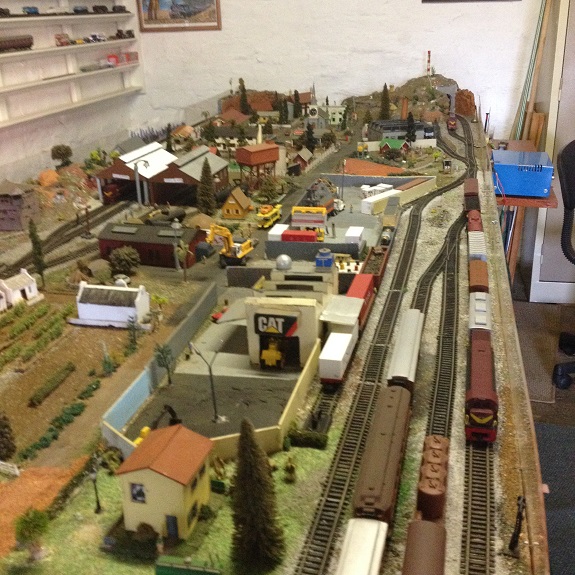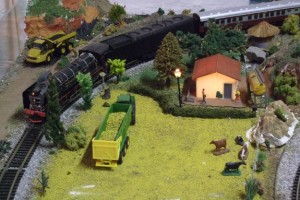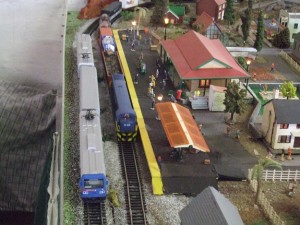Model Trains
Everything on model trains, model railroads, model railways, locomotives, model train layouts, scenery, wiring, DCC and more. Enjoy the world's best hobby... model railroading!
Although Scott focuses on HO scale, the answers to his question will no doubt be of interest to folk using other scale. Scott asks readers:
“Can double locomotives help out in steeper grade? Can you have two trains hauling many boxes? What is maximum number of boxes can one train can haul? Two trains? On gradients? Thanks.”
“I have a Rivarossi Allegheny Locomotive. Has anyone converted a recent model to DCC plus sound? I know space is tight in the loco shell when looking at the tender. Any advice out there please. I am looking at Digitrax decoder. Regards J”
 Nancy is having a problem with a brand new Lionel Silver Bell Express and asks:
Nancy is having a problem with a brand new Lionel Silver Bell Express and asks:
“We purchased an O scale Lionel silver bell express set yesterday. The track is together tightly, the lights and sounds are working, but the train does not move. We took it back to the dealer and it worked on his test track with no problem. Brought it home and it worked for about 2 minutes, then stopped and it won’t move again. Any ideas?”
John has a question for G scale enthusiasts:
“How do I wire a garden railroad with 5 turnouts and 350 ft of track? Any suggestions on where to start?”
George asks readers:
“I have a small 7×5 oval layout 00 gauge with tight corners (bends). Does any manufacturer sell a small wheelbase engines and passenger carriages (cars)? I am okay with goods wagons.”
Ian is interested in returning to model r ailroading and asks:
ailroading and asks:
“I have been a previously train buff but now after retiring I have caught the bug again after seeing all the action on this blog. The area I have is 5×5 meters (16 foot square) my ex computer room and I am thinking N gauge (N scale) for maximum track and rolling stock. Any suggestions please? In the past I have been involved in electronics. Regards Ian”
 Here’s a mix of old and new spotted on Ian Williamson’s N scale “Midway” layout. The scene is no location in particular, just a smallish city with a CBD. As can be seen this city is well serviced by public transport including trams that run frequently. Most of the buildings are by Tomy and Tomix, the trams come from the same manufacturers. The movements are controlled by an automatic train reverser with diodes in a block system.
Here’s a mix of old and new spotted on Ian Williamson’s N scale “Midway” layout. The scene is no location in particular, just a smallish city with a CBD. As can be seen this city is well serviced by public transport including trams that run frequently. Most of the buildings are by Tomy and Tomix, the trams come from the same manufacturers. The movements are controlled by an automatic train reverser with diodes in a block system.
David asks readers:
“Where can I fine pictures of different engines like SD-45, GP-35,F-45?”
David asks readers:
“I been trying to fine the kit to change HO Athearn engines from DC to DCC. Does any one knows will to fine the kits I need?”
Peter Field from Pietermarizburg South Africa sent in an update of his model railway to share with readers.

Looking up along the layout at the bottom is the farming area, middle are the factories and top end of the board is the village.
He’s what Peter has to say –
In an article some years ago I built a board which was basically a demonstration board of 1.80x 1.20m that was portable for model train shows.

A class 25 Condenser hauling the Trans Karoo passes the Anglo Boer war block House on route to its destination.
The next phase of the building plan was to make it a permanent layout still being 1.80x 1.20m and broke the board up somewhat to modify it and to extend it at a later stage.
In 2013 I started to expand the board and added another 1.80×1.20 board to the existing board which was now 3.6meters in length, this took almost a year to complete and add the scenery etc. Then at the end of 2015 I extended the layout yet again by 500cm making to the total layout 4.10x 1.20meters in size.
The layout was built to represent the South African railways in the early 1960’s up until the mid 2006 period.
When steam and diesel were working side by side on many of the SAR lines. There were the mighty Class 25 condenser locos to the Class16E a Pacific grey hound and the 15CA on many lines mixed with diesels of various types from the Class31, 34. 35, 36 and some SAR electric locos Class 6 E1.
The layout is based on a rural area of the Midlands in Natal with a general dealer, Hotel, Church, Garage and some factories and farms on the one side of the layout all served by rail.

The Hilton station with an EMU on the adjacent line whilst a goods train hauled by a Class 34 diesel glides past the station.
The village has plenty of action with people doing what people do taking dogs for walks people shopping at the grocery store ride motor cycles, people getting married at the church people working on the roads, offloading containers in the container bay area. Plenty of motor vehicles and trucks and farming implements on the farms.
The track in total is +- 8.20min length plus all the sidings along the line which is operated off a dual controller which powers the rails and the 16V supply to the towns lights and street lights etc.
The trains can vary from the Crack Trans Karoo express to the Blue train or mixed goods trains Coal trains or container trains or even a fuel train as the operate in block trains over here for say coal.
We also have a 1940’s balcony coach train of wooden stock to represent that era with the first diesels imported into South Africa the Class 31 or a fast passenger train hauled by a Class 25 condenser or a pair of Class 34 diesels. There is also an EMU suburban train that operates every so often. Trains are made up in terms of the periods when they would have operated on the SAR. The whole idea was to show what the South African railways looked like in the respective periods.
I call this layout “My world” as it was in my young years to the mid 1970’s when I saw the railways in the period of my life from a young boy to a young adult . There nothing more relaxing than to go into my train room and sit operating trains shunting and making up trains for the next session and to repair trains that are damaged or broken.
Ronald asks readers:
“I’m about to start my HO layout and considering Walthers Code #83 flex track with a couple of sidings. Am I making a good choice?”
Bob from the UK sent in this story:
I had until 3 months ago an up and ‘almost’ running layout in my loft, then-I broke my left hip-which shouldn’t be a problem NORMALLY, but it is giving me a lot of grief. On top of that my right hip which was replaced 4 years ago is also giving me grief, on top of that my spine is knackered, there are gaps where there shouldn’t be so I constantly get trapped nerves.
Apart from that I’m ok because I’m able to make single DIORAMAS which is what I’m doing now in my spare upstairs bedroom. Currently I’m making WATERLOO STATION and tracks plus turnouts. This has been a marathon job but I’m determined to finish it and God willing my Left hip will be okay in the future – when ever that might be. Morphine doesn’t help one bit, but with my other hobby Amateur Radio which I have been on since 1978 keeps me sane.
Enough said, I look forward to the future, because there is always hope.
The York Model Railway Show is one of the biggest in the UK and usually hosts around 40 working layouts. These photos were taken at this year’s Easter show. Well done to all involved!
Tim asks readers:
“What do the nos. in front of the loco. ,0-6-0, 4-4-0, 4-8-4, etc mean?”
Kevin would like to hear your preferences with regards locomotive brands:
“I am completing an 4′ x 8′ N scale layout and am at the point where I going purchase two diesel locomotives. I am looking for recommendations as to high performing locomotives that other model railroaders have had good experience with. My layout uses Kato Unitrack. Thank you in advance.”
Part 1 (Sorry about the ads on these videos. They are out of my control. I can’t get rid of them.)
Part 2
Ian asks readers:
“I don’t know about T.M.C.C. and would appreciate any pointers to help fill in my knowledge gap. I have heard others talking about Radio Control similar to model aircraft and wonder if it a real possibility to set up this method as I am about to retire D.C. for my H O setup and am at the decision time. Comments from the Blog will be of great assistance.”